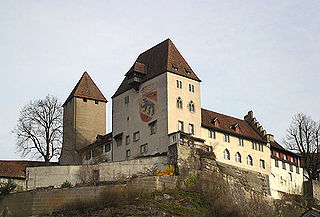Falkenstein or Falckenstein may refer to:

The Falkenstein is one of the best-known climbing peaks in Saxon Switzerland. It is situated near the rocky Schrammsteine ridge southeast of the town of Bad Schandau. The Falkenstein is nearly 90 m high and consists of sandstone. In the Middle Ages there were fortifications on top of the rock. Even today, the steps carved into the rock are still visible.

Dreieich is a town in the Offenbach district in the Regierungsbezirk of Darmstadt in Hessen, Germany. The town is part of the Frankfurt Rhein-Main urban area and is located roughly 10 km (6.2 mi) south of downtown Frankfurt am Main. With a population of more than 40,000 it is the district’s second largest town.

The ruins of Falkenstein Castle is in the Weinviertel region of Lower Austria, about 55 kilometres (34 mi) north of Vienna near the border to Czech Republic.

Neu-Bamberg is an Ortsgemeinde – a municipality belonging to a Verbandsgemeinde, a kind of collective municipality – in the Bad Kreuznach district in Rhineland-Palatinate, Germany. It belongs to the Verbandsgemeinde of Bad Kreuznach, whose seat is in the like-named town, although this lies outside the Verbandsgemeinde. Neu-Bamberg is a winegrowing village.

The Grafen von Falkenstein was a dynasty of German nobility descending from the Ministeriales of Bolanden, who held land and a castle at Falkenstein in the Palatinate region.

The Burgdorferkrieg or Kyburgerkrieg was a war in 1383-84 between the counts of Neu-Kyburg and the city of Bern for supremacy in the County of Burgundy in what is now Switzerland.

Neu-Aspermont Castle is a ruined castle in the municipality of Jenins in the Canton of Graubünden in Switzerland. It is a Swiss heritage site of national significance.

Burgdorf Castle is a castle in the municipality of Burgdorf in the canton of Bern in Switzerland. It is a Swiss heritage site of national significance.

Blauenstein is a castle fort on a rocky outcrop north of Kleinlützel, Switzerland.
Neu-Signau Castle is a ruined castle in the municipality of Bowil in the canton of Bern in Switzerland.

Falkenstein Castle, also called New Falkenstein (Neu-Falkenstein), is a ruined hill castle at 450 m above sea level (NHN) in the eponymous climatic spa of Falkenstein, a quarter of Königstein im Taunus in the county of Hochtaunuskreis in the German state of Hesse.

Neu-Schauenburg is a ruined castle in the commune of Frenkendorf, Switzerland. It is located near the border of France and Germany, and little of the castle remains because of geological events.
Alt Homberg Castle is a ruined castle in the municipality of Wittnau in the canton of Aargau in Switzerland. The castle is classified as a Swiss heritage site of national significance.

Neu-Süns Castle, Neu-Sins Castle or Canova is a ruined castle in the municipality of Domleschg in the Viamala Region of the canton of Graubünden in Switzerland.

Bubenstein Castle, also called New Falkenstein Castle (Neu-Falkenstein), is a ruined spur castle at 560 m above sea level (NN) on a rock spur on the northern side of the Höllental valley, about 500 metres west of Old Falkenstein Castle above the village of Falkensteig in the municipality of Buchenbach in the county of Breisgau-Hochschwarzwald in the southwest German state of Baden-Württemberg.























